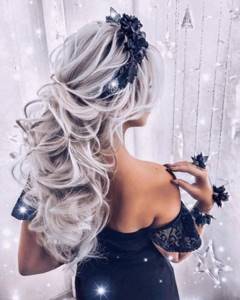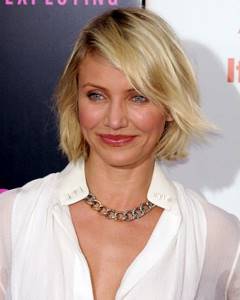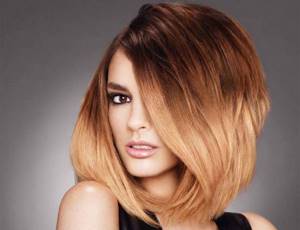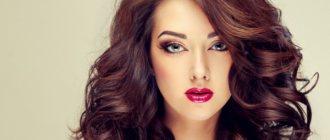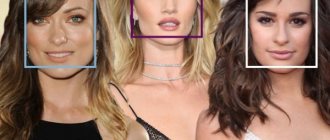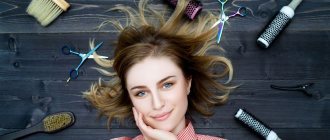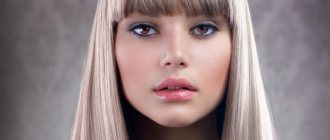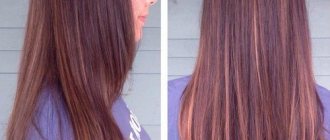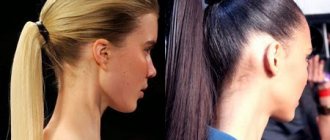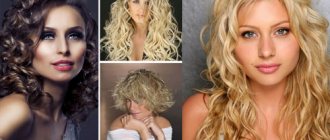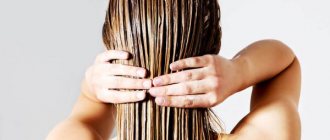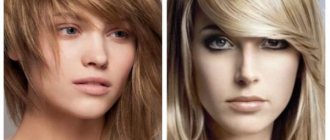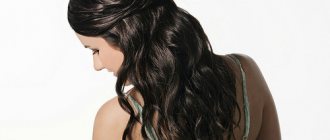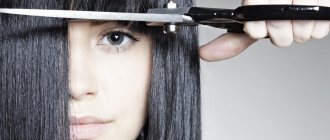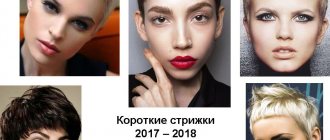What is this
Ombre is a special coloring process in which two shades are applied simultaneously. The goal of the cosmetic procedure is to create a smooth transition from a light shade to a dark one, and vice versa. It involves using the entire volume of the head.
Ombre coloring appeared recently, but is already a popular procedure in beauty salons. Initially, its purpose was to lighten by several tones, now it is used to create a bright and unique image.
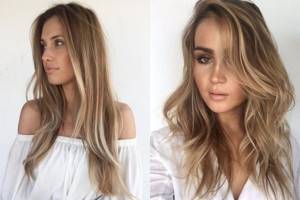
It’s not difficult to figure out how to make ombre at home without help. It’s better to start with the simplest thing – classic coloring. It involves changing the color of the tips 1-2 lighter than the main shade. In addition to it, there are three more types of hair coloring from dark to light, and vice versa.
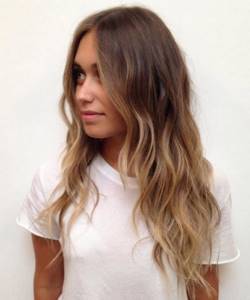
- Reverse ombre. Changes in the color of the roots with a smooth transition to the main curls. Looks good on blondes who want to darken the top of their head.
- For brunettes. Ombre dyeing on dark hair, creating a contrast of shades, it is possible to lighten the ends in any color, for example, red, chestnut, light brown or chocolate. It is possible to change the image using blue, green and ash colors.
- For those with light brown hair. Ombre for medium brown hair, short hair or long hair - the possibility of changing the appearance of the ends by dyeing it in an unnatural color, for example, peach, red, blue or purple.
- For blondes. Ombre hair dyeing for blondes is done to refresh the hairstyle or highlight facial features. There is no point in lightening already light hair. Most often, hairdressers adhere to the technique of color dyeing or creating a burnout effect.
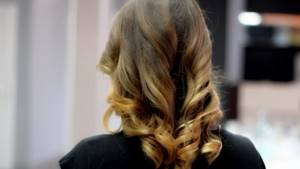
In addition to the main types of hair coloring techniques, there is a special hair color stretching. This includes degradation, ombre, shatush, flame effect and shadow painting. All of them involve creating a smooth transition along the entire length using several shades - from 2 to 4.
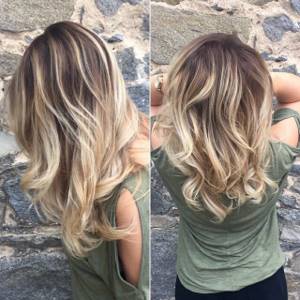
Attention! The advantage of painting is that you do not need to constantly touch up the roots. Thanks to it, you can visually create additional volume and an extravagant image.
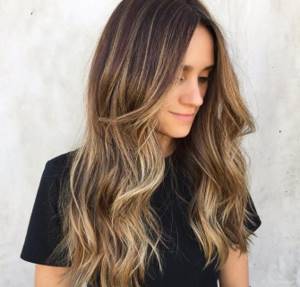
Coloring
Coloring is a dyeing process in which absolutely any shades are applied to the strands. Light brown hair benefits from this proximity, and its owner acquires a bright personality and immediately stands out from the crowd.
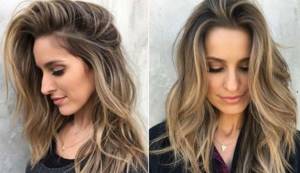
Coloring is a labor-intensive technique, but the result is worth the effort
Subtleties of coloring:
- All selected shades of paint must be of the same tone and combined with each other.
- To get a deep, rich result, you should use as many different shades as possible.
- The strands are dyed partially or completely, their size varies from thin to wide.
- A light shade is always used as the base, and bright strands enliven it.
- Bronding requires constant care and timely painting of overgrown roots.
- Changing your usual styling creates a new look every time.
Dyeing technique
Hairstyles differ in color. The staining technique itself in this case remains similar. The color is chosen depending on eye color, face shape and preferences. The dyeing process itself varies depending on the length of the hair.
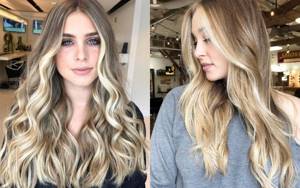
For long curls
It is recommended to do ombre for long hair in pink or light brown tones to make the face expressive and attractive. This style is suitable for those with fair skin and eyes.
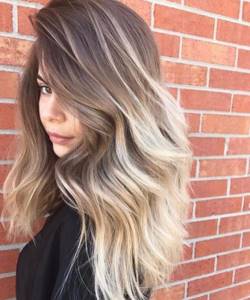
For dark-skinned women with dark, thick eyebrows, it is better to darken the lower part. It is better to do it using the ombre technique, which involves a smooth transition of shades along the entire length of the curls.
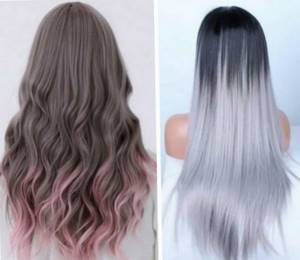
For medium length
On medium-length hair, a colored ombre applied to the ends looks more successful. Firstly, it visually makes the curls a little longer. Secondly, it becomes possible to emphasize facial features and make eyes and lips more expressive.
For short length
There is no need to dye your hair on short hair, it will look vulgar and unnatural. You can slightly highlight the roots and ends of curls on women's haircuts, like a bob or a bob.
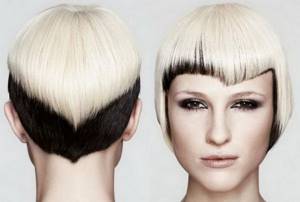
You shouldn’t do it in color either; it’s better to choose shades that are close to natural.
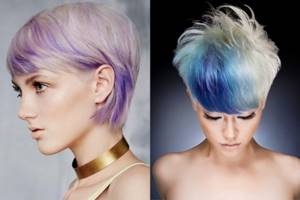
French highlighting
This type of highlighting is one of the most gentle. The substances used to create it do not contain ammonia. On the contrary, beeswax, which is found in such paints, additionally nourishes and heals the structure of the follicles.
Separately, the following features of French highlighting should be noted:
- adding volume to even very thin strands;
- decorating your hair with shining highlights;
- does not require long sitting in a hairdressing chair, the procedure is completed in no more than 2 hours;
- hides gray hair well;
- does not cause allergic reactions;
- allows you to give your hair shine and a well-groomed appearance;
- does not leave sharp transitions between natural and colored strands;
- does not destroy hair follicles and does not disrupt the structure of the curl.
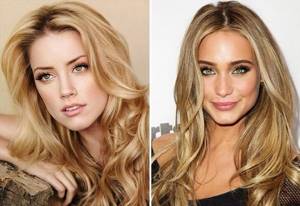
For those with weak hair, French highlighting is suitable.
The following shades look great on light brown hair:
- Honey and milk.
- Golden and beige.
- Nutty and light coffee.
French highlighting is performed in several types:
- Classic: along the entire length of the curls, in a chaotic order.
- Impact on the upper strands: decorates short haircuts.
- Tip coloring: creates a natural effect.
- Partial: used to frame the face with individual strands or color the bangs.
How to make at home
Often women refuse to do ombre on blonde, medium or short length hair because of the price of the procedure in the salon. If you follow the step-by-step instructions, the procedure can be performed at home:
- Select paints and mix according to instructions.
- Comb your strands thoroughly. Pull them into a ponytail.
- Divide all the curls into several strands. Comb each one separately.
- Using a stiff brush, carefully apply paint to the ends. Leave it to soak for 30-35 minutes, then rinse it off.
- Treat your curls with a softening shampoo and conditioner, and apply a moisturizing spray or oil.
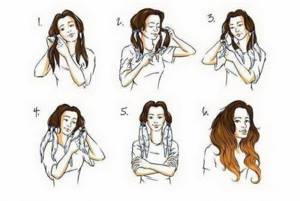
For blondes, ombre with highlighting of the ends is recommended; you can stretch them to a third of their length. This method of painting is especially suitable for those women who want to stand out, but are afraid of drastic changes. Reverse ombre is performed depending on the color of the curls - for fair-haired women it is better to use supra or an oxidizing agent with a concentration of 3%, and for brunettes from 6 to 9%.
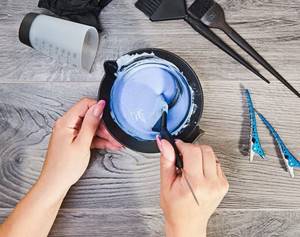
Attention! Before starting the procedure, perform an allergy test. Apply a small amount of the composition to the wrist or elbow area. If no irritation appears within 15-20 minutes, you can apply it to your head.
Rules for dyeing long curls
In the photo, ombre always looks natural and natural. This is due to the fact that the specialist chose shades that are close to each other in the palette. If you apply paint along the entire length, then it is important to make an indent of 5-7 cm from the roots.
Stages of highlighting
Comb your hair, put on the prepared cap and begin pulling strands through the holes in the cap. Try to get strands of equal width. When using a store-bought cap, strands can be taken out from each hole, or at intervals (medium and intense highlighting), depending on the desired result. It is more effective to dilute the composition in a container after threading the strands through a cap - this way you will work with freshly prepared mass, and this will improve the result. Apply the prepared mixture to the strands threaded through the holes of the cap. When applying, work with light movements, never crumple the strands to prevent smudges through the holes in the cap. To enhance the effect, it is sometimes recommended to use plastic film - this increases thermal insulation, thereby accelerating the chemical reaction for lightening. The waiting time is usually indicated in the instructions for the lightening agent. The interval may vary depending on the hardness and original color of the hair. Typically the procedure time is from 15 to 45 minutes
It is important to maintain the recommended interval, otherwise the hair may be damaged or the result may not meet expectations. You should independently monitor the progress of lightening: due to the increased porosity of the hair, the effect may occur earlier than the stated time. At the end of the procedure, the lightening cream should be thoroughly rinsed from the hair without removing the cap.
Next, free your head from the headdress and wash your hair again with shampoo and conditioner to nourish it after lightening. Hair restoration is necessary after any lightening, so this stage should never be ignored. Home highlighting kits often contain nourishing masks for post-procedure care. The final stage is tinting the strands, which is necessary to soften and prevent visual changes in color. It is better to carry out this work at least three days after lightening; you should not overload your hair with unnecessary chemicals.
- It is not recommended to use previously highlighted strands when re-dying; this can harm the quality of the hair structure.
- You should not wash your hair before dyeing; this will create a natural protective effect that allows you to resist the negative effects of the oxide.
- Any lightening does not require preliminary preparation in the form of moisturizing the scalp
- To prevent the occurrence of an allergic reaction, it is better to conduct a test reaction on a small area of the hand, according to the instructions for the coloring composition.
- For thin and weakened hair, do not rush into the lightening process; it is advisable to thoroughly treat the hair first.
- The thinner the “feathers” are when threaded through the cap, the more natural the result will be.
- There are classic highlighting and zonal highlighting. The first type involves coloring the entire length of hair threaded through the cap. Zonal – work is carried out with individual sectors. It opens up wide possibilities for creativity: “asymmetry”, “diagonal”, root application of the coloring composition, “avant-garde” and many other types of intermediate coloring.
As a rule, highlighting through a cap on short hair (the photo shows the result of dyeing in the article) turns out no worse than when carrying out the procedure in a salon. If the result does not suit you, it will be easy to fix it. But with long hair everything is more serious. If you are not sure of success, it is better not to take risks, but trust the specialists in the salon!
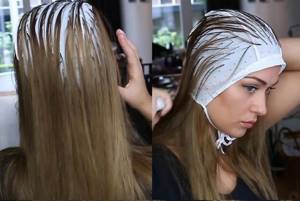
Is it suitable for everyone?
Ombre for dark, blonde hair of medium length suits all women, regardless of skin color, eyes, face shape and eyebrow type. But it is important to choose a shade. For example, a bright colored ombre suits young and determined girls more; it will look ridiculous on mature ladies.
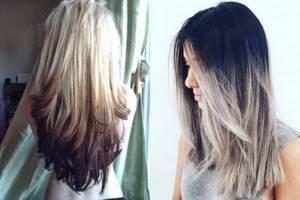
If the strands are curly, then it is better to make smooth transitions from one shade to another. Wavy curls will look playful and have more volume. This ombre look is suitable for those with thin hair.
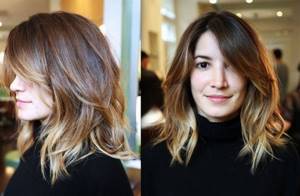
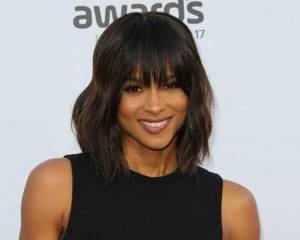
It is not enough to just dye ombre hair correctly for long hair; it is important to follow further care in order to permanently consolidate the result of the cosmetic procedure. It boils down to this:
- Avoid using a hair dryer, curling iron or straightening iron; frequent use of them leads to dry ends;
- do not comb after washing, let dry naturally;
- use hygiene products according to the type of curls, recommended on a natural basis;
- Moisturize regularly with masks, lotions, sprays or oils.
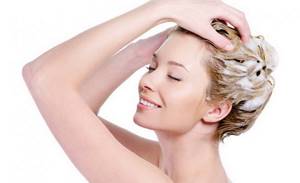
With proper care, the hairstyle will last longer, and the curls will look natural. The roots need special care. They need to be constantly painted, since the color of the shoots will stand out noticeably against the background of paint.
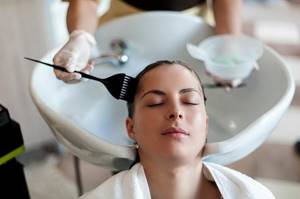
Attention! If you have no experience working with cosmetic paint, it is better not to experiment and go to a salon. The hairdresser will perform the procedure using gentle products and help you choose a shade. Recommend proper further care.
Ombre on dark and light hair is a procedure for those who want to change, but at the same time are afraid for the result. First, you can paint a part in a new shade, and then, if desired, completely change the image.
Brazilian highlighting
To create sun highlights on the hair that are visible from a certain angle, the Brazilian technique is used.
Principles:
- most of the small strands undergo complete lightening;
- then they are painted in different shades of the same color;
- The highlighting is multi-shade, due to this the maximum naturalness of the result is achieved.
Advantages of Brazilian technology:
- Gentle effect on curls.
- Suitable for hair of any structure, including curly.
- It distracts from facial skin problems and is suitable for mature women.
- Adjustments are made every six months.
- Gives additional volume to fine hair.
- Perfectly hides gray strands.
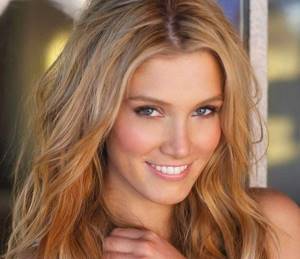
It is better to consult with an expert regarding Brazilian highlights.
An important feature: Brazilian highlighting may not suit a woman’s appearance type. Therefore, you need to involve a professional in its creation, who will suggest, if necessary, other coloring options.
Shades used for Brazilian highlights on light brown hair:
- mocha and honey;
- gold and wheat;
- sand and caramel.
Types of ombre:
Ombre is a common option for coloring ends. In this case, the execution is similar to balayage, where the strands are painted by hand and a smooth glare transition from dark to light (or colored) is created. The technique is suitable for any length and looks impressive on women of all ages.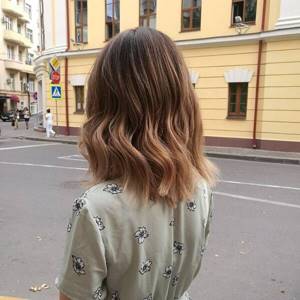
Classic
differs from the classics in that the roots are painted, not the ends. It is suitable for blondes who do not lighten their ends, but rather darken or dye them red, cherry, or burgundy.
Reverse
- a method in which a color gradient is made. As a rule, the result is up to 3-4 shades. This coloring looks beautiful on dark hair. The transition starts from the middle of the length and the color extends to the ends. When performed correctly, the technique results in a smooth transition from natural roots to bleached, almost white ends.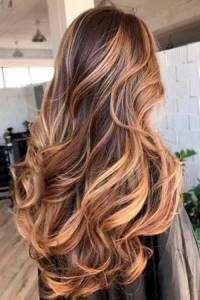
Degrade
- a relatively new and improved technique in which the dye is applied along the entire length, and a natural transition is obtained, the effect of burnt hair from several shades.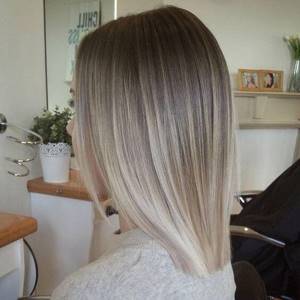
Sombre
- This is a two-tone coloring that creates not a smooth transition between colors, but a clear line. Looks great on shoulder-length and longer hair. Painting looks impressive, with contrast between colors, for example, too dark roots, almost black and bright ends (white, platinum blue). Shatush is difficult to make on your own, so it is better to entrust this technique to specialists.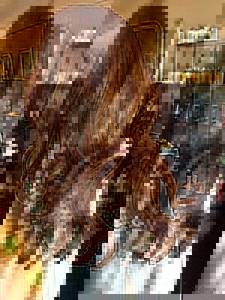
Shatush
– option using bright shades: blue, green, lilac. Initially, you need to lighten the color in order to tint it later. The technique is the same as with classic ombre, only the last step is to apply bright paint or tonic. This coloring looks great in a braided hairstyle.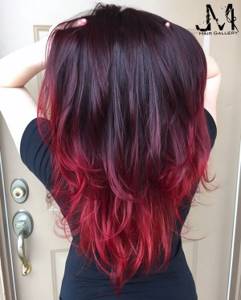
Shadow
- This is a coloring method that is practiced on burning brunettes. Instead of lightening, the ends are painted in a fiery shade (copper, golden, which creates the effect of fire).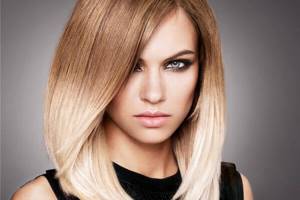
Flame effect
Peculiarities:
- coloring is done vertically by hand, without using caps or foil as in highlighting;
- at the client’s request, only the tips, half the head, or the larger part with a slight deviation from the root part are lightened;
- Several tones are used: close to the natural color, and several lighter ones. If you have bangs, you don't need to dye them.
Advantages and disadvantages of technology
The main advantage of ombre is that it does not require frequent touch-up of the roots, as with standard lightening. In addition, you can list many more advantages:
- visually looks more voluminous and this is an option for owners of thin and thin hair;
- makes it possible to experiment with any color and shade;
- the simplicity of the technique allows you to paint at home;
- The roots and scalp are not damaged.
In addition to the positive factors, there are disadvantages to this coloring:
if lightening is carried out before applying the tone, this dries the ends and causes fragility;
Venetian highlighting
This technique is similar to the Californian one in that it involves the use of foil, several shades and exposure to the roots of the hair. To create amazing shimmer, paint is applied to the strands using a special brush.
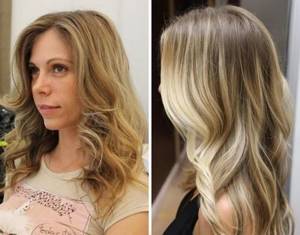
Using Venetian highlighting you can get soft transitions
Advantages:
- maximum naturalness due to chaotic application;
- changing your appearance without using drastic coloring techniques;
- will effectively decorate hair of any length;
- does not require frequent updates;
- the color turns out very deep.
Ombre hair coloring technique for different hair lengths
Can be done at any length. When coloring short hair, there is no special technology, because it depends on the length and type of haircut.
For long hair
On long hair, coloring looks more beautiful because a smooth stretch of shade from dark to light is achieved using a wide range of shades. Due to this, ombre looks as beneficial as possible on long hair.
You need to focus not only on the length, but also on the shape of your face, eye color, and skin type. For example, black color will not suit fair girls with white skin and light eyebrows. For them, it is better to choose pink shades, Tiffany color, or do a reverse ombre with darkening the lower part so that the face remains a lightened natural blonde.
Long hair is dyed using different techniques and can be done from a clear transition to long stretches of color in the sombre style.
For medium hair
Any type of ombre can be done on medium-length hair. As for curly hair, the classic version looks great. Whereas on short hair, colored ends look impressive. This length allows you to focus on facial features, express your eyes and lips.
For short hair
If the length is less than average, it is better to refuse ombre. This type of painting is done at different lengths, starting from the middle of the ear. The transition looks impressive on bob, women's finger, or bob haircuts.
At the same time, there are some rules and features of applying the coloring composition:
- for the transition to be noticeable, you need to retreat from the roots at least 3-4 cm;
- the paint is applied “by hand” without the use of foil or film, as with highlighting;
- short hair is not backcombed;
- painting is done in the same way as highlighting or balayage.
After dyeing, you need to thoroughly rinse off the dye, apply a mask or conditioner to your hair and rinse well with shampoo.
Reverse highlighting
The direct type of highlighting quickly loses its attractiveness due to the fact that the ends become too light. This happens due to the lack of timely correction, incorrectly adjusted proportions and coloring of most of the curls.
In this case, it makes sense to resort to the reverse type of coloring, which has the following features:
- the shade of previously colored strands is evened out;
- at the roots, paint is used that is lighter than for the ends;
- the specialist chooses shades that are a couple of tones darker than the natural color;
- the transition between dyed and natural strands looks natural.
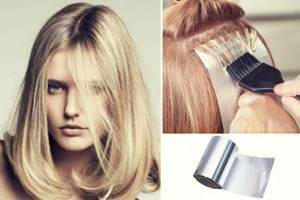
The reverse highlighting technique will correct previous coloring
Reverse highlighting stages:
- The desired shade of paint is applied to the ends and they are packed in foil.
- Then the same procedure is done with the ends.
- The correct choice of shades and width of strands is important.
- After 40-50 minutes the paint is removed.
Proper care after the procedure is important:
- the use of masks that strengthen the hair structure;
- use of balms after washing;
- periodic use of toning shampoos.
How to make a classic ombre at home?
This type of painting is considered expensive due to the technique and the length of time it takes to complete. In addition, if ombre is done on a brown-haired woman, preliminary bleaching will be required. At home, you can dye the ends yourself.
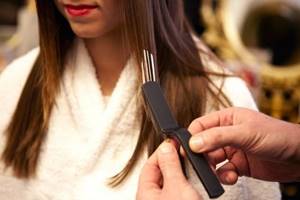
First you need to decide on the color scheme and purchase paint, brightener, and a brush for applying the composition. Algorithm of actions:
- Comb your hair and tie it in a ponytail to color the ends (this is the easiest way to do your own ombre).
- Divide the tail into small strands and comb each one. This is necessary in order to create a smooth gradient transition from natural to colored hair.
- Dilute the paint according to the manufacturer's instructions, which you are advised to read. If you want to create a fashionable shadow ombre on dark hair, lighten it first. In this case, use supra and oxidizer. It is better for fair-haired people to use 3%, for those with too black hair – 6% or 9%.
- Apply the dye for half an hour, then rinse it off and apply a balm or mask to your head to “reanimate” your hair after an aggressive lightening composition.
- The last stage is tinting in color, if necessary. For brunettes, you can apply color to the tail without fear of affecting the natural color, since the dye won’t stick to it anyway.
After this, you need to thoroughly wash your hair and apply protective oil to your dyed hair, which will prevent split ends and nourish the hair shaft.
When using paint at home, it is recommended to conduct a sensitivity test first to avoid causing irritation.
Ombre is a universal hair coloring technique that will help you change your image. Its advantage is that you don’t need to apply paint over the entire length, and if a girl is afraid of drastic changes, then you can only paint the ends and stretch the color to 1/3 of the length.
Features and technique of staining
Highlighting using the “veil” method is done only on clean hair, so before the procedure you should wash your hair and dry it naturally. Veiling is done as follows:
- The upper part of the hair is separated, and the lower part is secured with a hairpin.
- The strands that are planned to be dyed are selected using the darning method. Select a curl 2 cm wide, which should be divided into small strands of 3 mm each. Leave them on your palms one at a time and immediately place foil under them. You can color it right there, but it’s better to secure this design with a hairpin and proceed to the next curl.
- As soon as the entire upper zone is divided into strands fixed on foil, you can prepare the coloring composition.
- Now you need to work very quickly so that the lightening or coloring is as uniform as possible. Paint each piece of foil with curls and wrap the material in an envelope.
- Leave the dye for the required amount of time and rinse with running water. If desired, the strands can be additionally tinted.
Advice. You should not choose wide strands, as you won’t get a weightless effect.
The video talks about the veil highlighting technique:
Ombre on brown hair: interesting ideas with photos
Brown hair looks very feminine and gentle, but sometimes it seems too boring. The fashionable ombre technique will help you revive your hair, add volume to your strands and try new shades.
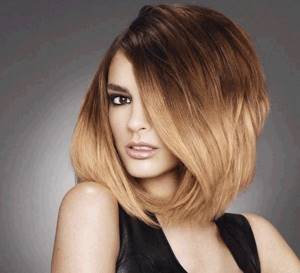
With its help, you can achieve the effect of naturally burnt hair, create smooth or sharp color transitions. Usually the procedure is performed in a salon, but with certain skills you can dye your strands at home.
Types of curls on long hair
Long hair is good because it allows its owners to experiment with their appearance. If desired, the image can be changed daily.
"Hollywood" curls
Visually these are large vertical curls. In this case, the direction of the curl is always directed away from the face. It is very important here to create a completely natural effect.
This is achieved by using several nozzles of different diameters. For the bulk of curls, a large diameter nozzle is used. With the help of a thin one, only a few strands are formed.
Before you create Hollywood curls, you need to create volume at the roots. The crown should be voluminous. To achieve a successful styling, when twisting the curl, you do not need to press the strand with a clamp. In this case, there will be no creases in the curl.
Curl at the ends of hair
Quite a popular hairstyle for long hair. It creates an absolutely stunning effect. But even in this case, it is necessary to create at least a small root volume.
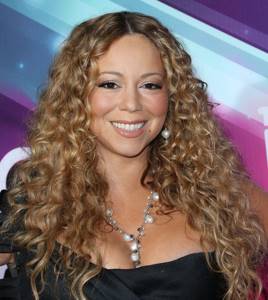
Corrugated curls
The most primitive way to create this effect is to use a corrugated attachment on an iron. If you don’t have one, then you can use a regular curling iron with a clip.
Do the installation like this:
- A thin strand is separated from the overall head of hair.
- It should not be screwed onto the round part of the device, but onto the surface of the clamp designed to hold the strands.
- We clamp the hair for about 15 seconds.
- Carefully remove the strand.
- In this way, the required number of strands is wound.
Small curls
Playful curls will add playfulness to your look. You can create a style either using spiral curlers or curling with a curling iron with a thin nozzle.
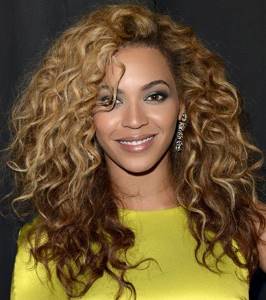
To achieve the desired effect, you need to take thin strands of hair. After finishing curling, you should not comb your hair. They are simply taken apart with your fingers. To consolidate the effect, it is recommended to use wax, applying it with light movements, as if squeezing the strands.
Large curl shape
Large curls look best at the ends of long hair or gathered into a hairstyle. Styling curls in this shape is suitable for hair with good thickness. It is performed using electric curling irons with a large diameter heating element or roller curlers.
Curls in the style of “slight carelessness”
To create a natural styling, you don’t need to curl your strands too much. They should be only slightly wavy. Stylists recommend using curling iron attachments of different diameters for styling. This also applies to the thickness of the strands: they should also differ from each other.
What is ombre
Ombre is a creative hair coloring option first proposed about 10 years ago. Since then, the technology has been improved; salon clients are offered at least a dozen options of varying complexity.
The essence of the technique is smooth or more obvious color transitions . Typically, the ends of the hair are left dark and the ends are highlighted or tinted. There is also a reverse ombre, in which the ends are painted in bright or dark colors, and the roots are left light or bleached, followed by coloring in delicate tones.
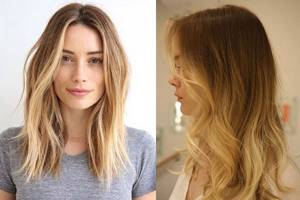
The procedure is performed in salons, but women who know how to handle dye can try dyeing at home. The technology can be applied to medium wavy, straight or curly hair, both natural and colored.
Advantages
The balayage coloring technique has deservedly gained immense popularity among fashionistas. There are several good reasons for this, and now we will tell you about them.
- A special multi-dimensional coloring technique using several shades is a great way to add visual volume, thickness and strength to your hair.
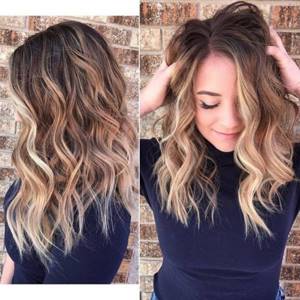
- Balayage can be done on hair of any length, with the exception of boyish haircuts. Haircuts without bangs or with them look equally good with this coloring.
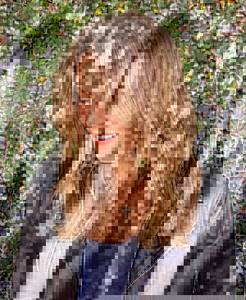
- With this technique, you can forget about the problem of overgrown roots. Since the dye applies only to the top layer of the strands from about the middle of their length, hair regrowth does not at all spoil the appearance of the hairstyle. Subsequent coloring may only be required after 3 months to maintain the result. During this time, you will not have to create any special hair care - classic procedures and removal of split ends will be enough.
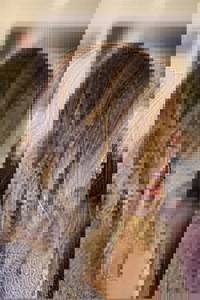
- Straight hair is the perfect base for balayage. On such hair, a smooth transition created between related tones looks great.
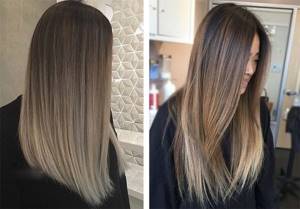
- But on curly and wavy strands, balayage is no less effective. It's so easy to create a particularly delicate and feminine look.

- This technique allows you to emphasize advantages and disguise disadvantages. A true professional will also be able to correct the oval of the face.
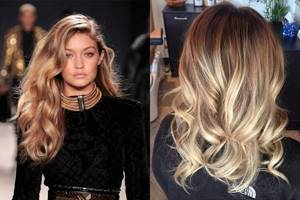
- Balayage using light shades is a real elixir of youth. This coloring distracts attention from wrinkles, refreshes the complexion and creates an image in the spirit of modern fashion trends.
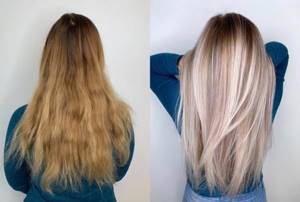
Who is it suitable for?
The ombre technique is ideal for women who want to experiment with color, but are not ready to go all out. The easiest way to tint is strands that take the dye well, are not too thick, but are not fragile either.
It is possible to dye hair of any length, but the effect is more noticeable on medium and long curls. Girls should try ombre
- those with thin and sparse strands, but dreaming of a more voluminous hairstyle;
- those who want to liven up a too boring color;
- those who like to experiment with shades;
- those who are afraid of too frequent staining.
Zonal highlighting
To create the softest shimmer of light curls, very thin highlighting is created, which requires a large amount of applied force and has a high cost. In addition, this technology captures, and therefore damages, most of the strands.
An excellent way out of this situation is to perform zonal highlighting, when not all curls are dyed, but only the upper part of the strands.
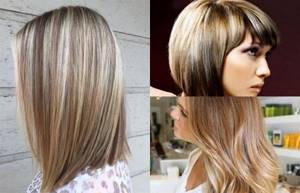
Zonal highlighting minimizes hair damage
Peculiarities:
- no impact on the entire structure;
- damage to curls is minimized;
- most of the hair retains its natural shade;
- the opportunity to emphasize certain features of the haircut.
Who shouldn't try coloring?
Despite its versatility, ombre is not for everyone. The procedure should be abandoned
- Girls with severely damaged, split ends, brittle hair. The effect of burnt strands is good if the hair is in perfect condition, otherwise the hairstyle will look untidy. A contrasting and colored ombre will highlight the poor condition of the hair.
- For those with very oily strands. The greasy roots against the background of the bleached strands will be striking. For a normal hairstyle, you will have to wash your hair every day, but this does not always save the situation.
Shades for highlighting light brown hair
To obtain the optimal effect from the coloring procedure, the correct selection of color shade is required. The latter, in turn, depends on the natural hair color.
According to stylists, the following colors fit ideally on light brown strands:
- ivory;
- butter;
- milk;
- platinum;
- coffee with milk;
- caramel;
- silver ash.
Important advantages of creating highlighted strands on light hair are the following:
- Highlighting is an effective way to color light brown curls, giving the owner style and extravagance.
- An excellent opportunity to add volume and shine to thin and lifeless strands.
- Hair practically does not suffer from exposure to chemicals, because only individual strands are colored.
- The ability to renew coloring no more than once every 2 months; the roots that have grown back are not very noticeable.
- Using the zoning technique, you can emphasize certain features of the haircut and hide imperfections.
- Highlighting looks good on haircuts of different lengths, with any structure.
- This coloring technique hides gray hair well.
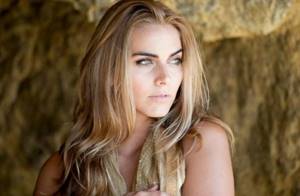
Highlighting on light brown hair can be done using a wide palette of shades
The procedure is not without some minor drawbacks:
- Difficulty performing the procedure at home without professional help.
- Duration of staining.
Shade selection
Before choosing paint, you need to decide on the general image. To create a natural effect, owners of light brown hair will suit all shades of blonde, from silver to deep honey.
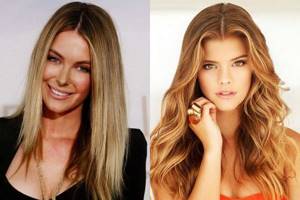
Brown hair usually has a cool undertone. Ash, silver, fawn colors are suitable for work. To create greater contrast, you can slightly darken the roots using a dye 2 shades darker than natural.
If your hair is colored in warm colors, you should use a straw, honey, creamy or golden palette. Dark brown strands will require preliminary lightening, the color will be purer.
Colorists suggest using professional brand dyes. Special ombre kits are intended for home use, including 1-2 tones of paint and a high-quality oxidizing agent.
Multi-tone highlighting
Dyeing strands in multi-tones or highlighting with highlights is a real hit of the season. The master specially selects shades that are close to the same tone, due to which spectacular overflows are achieved.
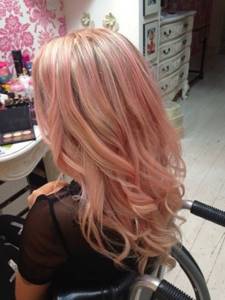
For the bravest girls there is multi-tonal highlighting
Coloring Features:
- smooth transitions between tones;
- use of several shades;
- a combination of bright and pastel colors.
Multi-tone technique allows you to use the following shades on light hair:
- cocoa and honey;
- wheat and gold;
- cinnamon and nutmeg;
- caramel and honey;
- cherries, currants and cornflowers.
Light brown hair, which has been professionally highlighted, seems to come to life. This effect is especially clearly visible under sunlight. This coloring technique allows you to revive a boring look, avoiding drastic changes and without spoiling your hair.
Types of ombre
Classic
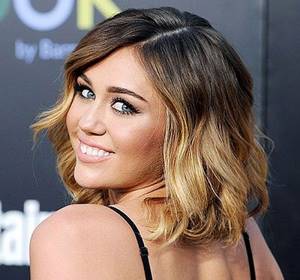
The classic version involves smooth transitions of natural shades.
The roots are left natural or slightly darkened using a soft ammonia-free dye.
On dark brown hair, the ends are lightened and tinted; on lighter strands, light dye is sufficient.
The strands may have a horizontal border, but sometimes the color is applied along the entire length.
This way you can highlight your facial hair or bangs, giving your hair extra volume.
Regrown roots
The easiest option to implement, a similar effect is easy to achieve at home. The roots remain dark, the ends can be very light, the middle part of the hair is worked out with 1 or 2 shades similar in tone.
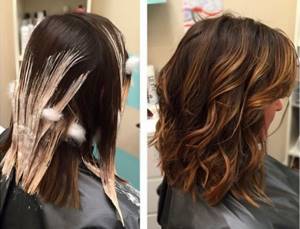
Transitions should be soft, the color border should be relatively high. This coloring looks especially beautiful on wavy or curled hair.
Burnt strands
The hairstyle looks very natural, but requires great skill from the colorist. At home, achieving a similar effect is not easy. The dye is applied to the ends and middle part, some strands are completely highlighted. Using the technique, it is easy to correct the shape of the face and visually increase the volume of the hairstyle.
Colored

A creative option that allows you to turn any gray mouse into an iridescent hummingbird.
Paints of different shades are used for work, from pastel to neon.
It is better to work with professional kits that are harmless to hair.
Some colorists successfully use food dyes; they give a very interesting effect on light brown hair. It is possible to use 1 tone or several at once. Color transitions can be smooth or clear, in the form of even stripes.
Ombre for light brown hair
It is believed that the technique is more suitable for dark brown hair color. The contrast with bleached or bright ends will be more noticeable. However, owners of lighter strands should not be upset. There are separate techniques for them that allow you to try on fashionable coloring and look great.
Reverse ombre. With this technique, the ends of the hair are darkened, while the roots are left light.
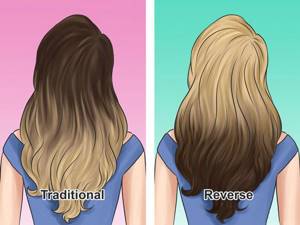
This option is suitable for perfectly straight hair, emphasizing an unusual contrast. A clear or blurred horizontal border is required.
Using a similar technique, you can create a “flame tongues” ombre by applying bright reddish or dark pink highlights in the form of zigzags and stripes on a light base.
Darkening of the roots. In this case, a dye 2-3 shades darker than your own hair is applied to the roots, the middle part is treated with a lighter tone, and the ends remain natural. The effect is very interesting, but you will have to refresh the color of the roots every 3 weeks. A growing light stripe will spoil the impression of your hairstyle.
And this video shows a non-standard use of the product for covering overgrown roots and gray hair. With its help, a blonde can very quickly turn into a dark-haired girl with spectacular ombre, and all this at home:
Important . Work with light brown hair should be entrusted to a professional colorist. At home, the effect can be unpredictable.
Classic frequent highlighting
Highlighting, which can be done on light brown hair, can be frequent.
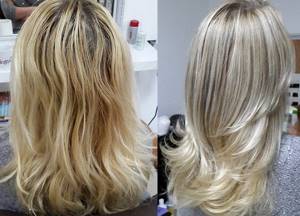
After classic frequent highlighting, hair gains volume
This procedure is gentle and has the following important features:
- the root part does not stain;
- the impact concerns only the upper strands;
- your own shade of hair is preserved as much as possible;
- most of the small strands are painted in colors that are similar in tone;
- curls acquire the missing volume.
Benefits of coloring
The ombre technique is best recommended for dark long strands, but owners of short haircuts can also experiment with their hairstyle. This coloring definitely adds originality to the look, especially suitable for those who like to stand out from the crowd. For dark hair, “shadow” dyeing is a softer way to turn it blonde. Thanks to its proper use, it is even possible to correct facial features.
Many representatives of the fair sex, wanting to preserve their natural color, lighten only the ends, thereby increasing the volume of their hair, adding brightness and lightness to it. But to create a truly stylish effect, you need to choose the right type of coloring, and with it, a good colorist.
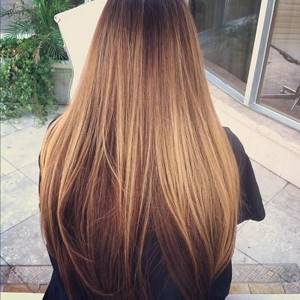
Concept of balayage
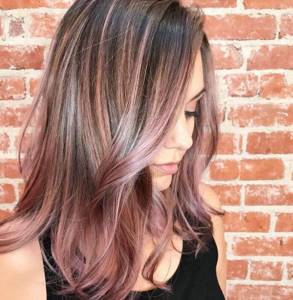
I think some of you have noticed that now not only the haircut matters, but also its color and the method of dyeing the hair. Therefore, you can see the appearance of red, pink, or gray heads on the street; whatever the trend, so is the color.
And now let's talk about one of the types of coloring.
What it is?
Balayage is a coloring technique that is one of the types of highlighting. With this coloring, you get the feeling that the strands have simply faded in the sun. The most important thing here is to choose shades from the lightest to the darkest so that the effect is smoother, but still noticeable. The method originated in the 1970s in France, but the buzz around it began relatively recently.
Peculiarities
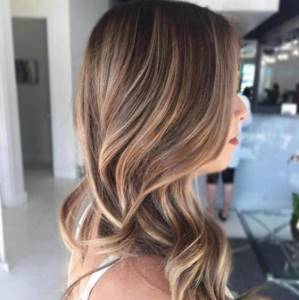
Balayage has its own coloring approaches. In the classic approach, they usually take 2-3 tones of the same color. For the modern version, they take a completely different color, but it should be one.
There is a natural dyeing option in this technique, which is when you take and dye several thin strands on the top of the head and near the face. With the latter method, the effect of sun-kissed strands will look more original and natural.
Features or advantages of the technology:
- It does not particularly harm the hair, since the hair roots are not affected.
- This coloring helps correct imperfections: oval face shape and hair thickness.
- Versatility, since this method is suitable for any light brown hair (no matter what length or structure) as well as for girls of all ages.
- It doesn’t matter whether you have a hairstyle with or without bangs, you don’t have to worry about updating the color, just don’t forget about your usual hair care and cut off dry ends.
Among the negative aspects of this technique is the difficulty of execution, i.e. you cannot do balayage yourself. But I think this is not so critical. Sometimes the disadvantages include the fact that visually balayage makes the face even wider in girls whose face is already not small. In my opinion, this is not entirely true, since it is the artist’s mistake that he could not highlight the strands in such a way as to “narrow” the face.
Varieties
As stated above, there are several types of balayage. Each of the presented techniques has its own distinctive features and characteristics, which are important to take into account when choosing the most suitable option. Let's take a closer look at what types of this coloring exist and what their characteristics are.
Classical
Of course, the classic balayage is rightfully recognized as the most popular and in demand. This type of coloring implies the presence of a smooth and maximally soft transition from darker roots to lightened ends. This solution looks unsurpassed on almost any haircut and is great for brown hair.
Despite the fact that classic balayage is the most common, it should still only be done by an experienced professional artist, since this technique is considered quite difficult to perform.
Hairdressers advise young ladies who have never tried this hair design and want to experiment to choose the classic option.
Amber
Amber balayage is perfect for light brown hair. It is recommended to use such a spectacular coloring if a young lady wants to make her hair more voluminous and voluminous. In addition, a haircut with amber balayage acquires the vitality and depth of color it lacks. This type of coloring can be applied to any hair, but the amber version looks best on short hair.
Hair care after coloring
After any coloring, including gentle coloring, you should help your hair recover. Nourishing masks, fortified balms, oils and sprays will serve this purpose.
The use of sulfate-free shampoos will protect your curls from dryness and prevent the appearance of yellowness. It is undesirable to frequently use a hair dryer, straighteners, curling irons, and it is undesirable to wash your hair frequently, especially with hot water. Daily use of hairspray is prohibited.
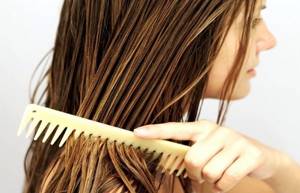
All masks are recommended to be done twice a week:
- Oily. Heat vegetable oil (it is better to take linseed, olive, burdock or castor) in a water bath until comfortable warmth. Add vitamins A and E in the proportion of 5 drops per 1 tbsp. oils If your hair is oily, add lemon juice in the same amount as the oil. Apply the mixture to the entire hair, coating the ends well. Wrap the curls in a bag and wrap them in a towel. After 25-30 minutes, rinse with shampoo for colored hair; no need to overexpose.
- Bread Mix equal amounts of dried nettle, plantain and oak bark. Pour boiling water at the rate of 200 ml per 2 tbsp. herbs, leave until cool, strain. Before preparing the mask, slightly heat the infusion and pour it over the rye bread crumb, grind everything with a blender until smooth. Distribute the mixture over the entire length of the hair, put it under a bag and a towel. Keep for about an hour.
- Yeast. It is preferable to use live pressed ones, they contain more useful substances that promote hair restoration. 1 tbsp. yeast, pour in the same amount of warm milk and add 1 tsp. Sahara. When min. After 15 minutes the mass will begin to ferment, beat in an egg if your hair is of normal oily content. If it is high, add only the protein; for dry hair, on the contrary, add the yolk. Rub the resulting mixture into your hair, cover with a bag and a towel on top. Wash off after half an hour.
Hair coloring can give the whole image sophistication, relaxedness, audacity or severity, depending on the color and dyeing technique, of which there are a great variety. Ombre looks especially good on brown hair, which will serve as a means of self-expression, rejuvenate and refresh the face, fit into any style and provide the owner with admiring glances.
Pros and cons: is it suitable for dark hair?
The main advantage of ombre extensions is that there is no need to dye your hair. You will wear ready-made strands with the desired shades. If you get tired of it, just take it off and return to your original hair color.
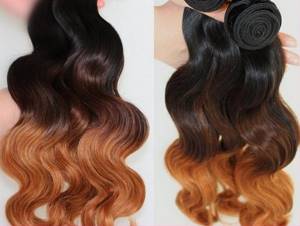
Other advantages:
- Beautiful and natural appearance. Strands dyed using ombre technology blend perfectly with natural hair color.
- If your hair grows slowly, the extensions do not put pressure on you, you feel comfortable wearing them, and frequent correction is not needed. Take it easy until six months.
- You can do any hairstyle, because in any form, ombre extensions will look neat and attractive.
- Thin hair automatically visually increases in volume.
- You pay about the same as for regular hair extensions.
Plus, it’s easy to disguise various flaws: scars, lack of hair in certain places, bad haircut, poor structure and color. Lightened strands rejuvenate and make the face look fresher.
Interesting! Ombre hair extensions are considered the ideal solution for those with hair that is naturally dark or dyed black, brown, or dark blond. It fits especially well on long curly locks.
Now it’s worth talking about the negative aspects of the procedure. You can remember all the disadvantages that apply to hair extensions in general and specifically to ombre. In the first case, this is an additional load on the head and hair, hence tension, inconvenience, periodic pain and fragility, and loss of your own hair. You also definitely need to make a correction, sometimes once every 2-3 months.
The meticulous, special care of donor strands deserves special attention, which should be tried to be combined with the care of natural curls. It’s very difficult to do ombre on your own without hairdressing experience; you can’t do it without the help of a specialist.
